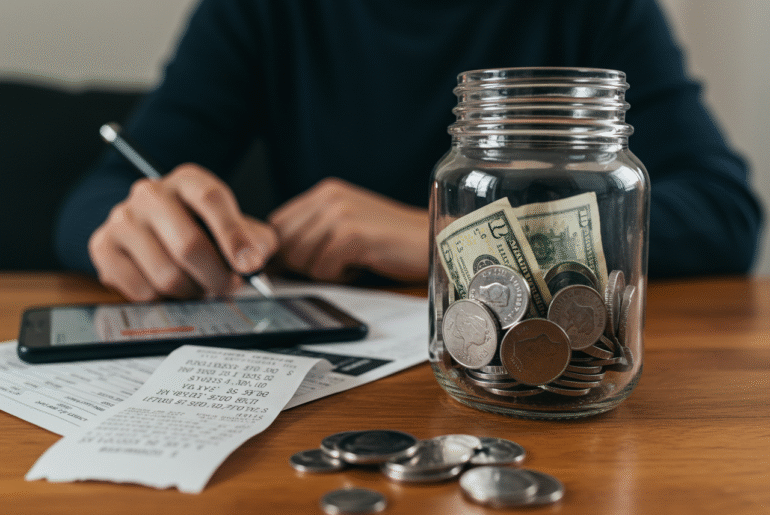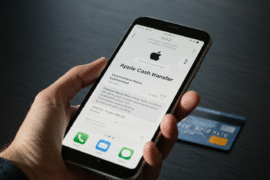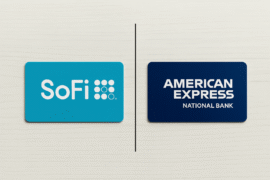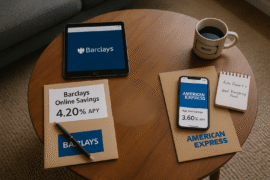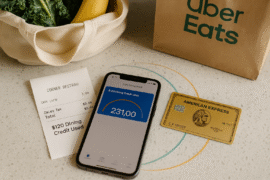This article may contain references to products or services from one or more of our advertisers or partners. We may receive compensation when you click on links to those products or services. Nonetheless, our opinions are our own.
The information presented in this article is accurate to the best of our knowledge at the time of publication. However, information is subject to change, and no guarantees are made about the continued accuracy or completeness of this content after its publication date.
- Top Savings Insights
- Introduction
- Challenges That Make Saving $1,000 Difficult
- Why Saving $1,000 Matters
- Common Obstacles to Saving Money
- Getting Started on Your Savings Plan
- Helpful Tools for Saving Progress
- Setting a Realistic Goal for Your Income
- How to Reach Your First $1,000
- Final Thoughts
- Frequently Asked Questions
- Recommended Reads
Top Savings Insights
- Learn how long it usually takes people to save $1,000 through everyday examples
- Discover challenges like impulse spending and forgotten subscriptions
- Explore practical tips to reduce spending and earn extra cash
- See how a savings account can help grow your money
- Use budgeting and cashback apps to track progress
- Understand how small daily changes can speed up your savings
Introduction
Saving $1,000 might feel like a big task, but you can do it if you have the right plan. It does not matter if you are putting money away for a rainy day or wanting to buy something nice. Small steps can really help you reach your goal. A lot of people in the US find it hard to save money. This is because they have regular bills and not much left over. Still, if you change some of your spending and make the most of what you have, you can reach your $1,000 goal. Let’s see how you can make this happen.
Challenges That Make Saving $1,000 Difficult
Saving $1,000 can feel hard. A lot of people in the US live from paycheck to paycheck. This makes it tough to save money. It gets even harder with things like extra spending and bills you didn’t see coming. One way to help is to open a savings account. You can also work on a simple budget. If you keep at it and pay attention, you can save up that money. Getting to this amount is a good goal, and with some planning, many of us can do it.
Why Saving $1,000 Matters
A $1,000 savings goal is often the first step to being more in control of your money. It gives you a safety net if you face things you didn’t plan for, like doctor bills, car fixes, or things that break at home. When you have an emergency fund, you do not have to use credit cards or take out loans if something goes wrong.
Reaching this first amount is a big step. It helps you get ready to pay down debt or start putting your money to work. Building good money habits and learning how to spend less put you on a strong path for what comes next. What matters most is not only how much you save but also the habits you build as you go.
Common Obstacles to Saving Money
Reaching your savings goal can be hard because of everyday money problems. If you find and work on these problems, you can get better at saving.
- Extra Costs: Buying things you don’t need or spending on stuff that isn’t important can use up your savings fast.
- Choice Spending: Eating at restaurants, going to fun events, and taking trips you don’t need can eat away at your money plan.
- Monthly Subscriptions: If you forget about streaming services or gym memberships, they can keep charging you, so check them often.
- Takeout and Food on the Go: Getting meals from outside all the time costs more than cooking at home.
If you fix these problems, you can have more money to put into your savings goals.
Getting Started on Your Savings Plan
To reach your $1,000 goal, start by getting ready. Open a savings account just for this goal. This helps you avoid spending the money and lets you earn some interest with time. A good budget is important if you want to reach your goal. Look at your spending, put your costs into groups, and find out where you can spend less. You can use things like banking apps or budget tools to make this easier and help you stick to your plan.
Helpful Tools for Saving Progress
Several resources can help make saving easier and better.
- Budget Apps: Tools like Acorns and Mint help you watch your spending and add money to your savings automatically.
- Cashback Apps: Apps like Ibotta give rewards for your daily shopping, so you can put this money into your savings account.
- Banking Solutions: Many banks give you high-yield savings accounts and apps that let you move money often with ease.
- Ebooks and Guides: Try free ebooks or guides that show you saving tips made for your income.
These tools help you keep track of how you are doing. They also make sure you get the most out of your work.
Setting a Realistic Goal for Your Income
Your savings goal needs to match your income. When you set goals you can reach with what you get in your paycheck, it is easier to stay on track and not feel upset.
| Income Level | Savings Goal/Month | Realistic Timeline |
|---|---|---|
| Low Income | $50–$100 | 10–20 months |
| Moderate Income | $100–$200 | 5–10 months |
| High Income | $300+ | 3 months or less |
People who earn less money may put in a smaller amount each week. Those with higher incomes can save more money by putting in bigger amounts. High-yield accounts can help make these savings grow even more by paying interest.
How to Reach Your First $1,000
1. Look at Your Spending Habits
First, take a good look at where the money is going. Find out which things you must pay for and which things, like eating out or buying clothes, are extra. Try to make better choices with the money. This can help you set aside more for your savings.
For example, you can save money by grocery shopping with store brands. You can also use cashback apps like Ibotta to get some money back. Look at your monthly bills to see if you find any charges that can be reduced or removed. This can be things like subscriptions you do not use.
2. Make and Follow a Budget
Having a good budget can help you stay on track. You can try systems that fit you, such as
- 50/30/20 Rule: Put 50% of income to things you must pay for. Use 30% for things you want. Keep 20% for savings.
- Apps for Automation: Tools like Acorns make it easy to follow where your money goes.
- Cash Limits: Use cash envelopes to help you spend only what you plan.
- Expense Prioritization: Tell apart needs and wants. Always try to save first.
Every bit that you add, even if it is small, helps you reach your goal. When you stick to your budget, you keep yourself from spending money on things you do not need.
3. Cut Out Costs You Don’t Need
Cutting out costs you do not need can help you save money fast. Look for charges that come up again and again if they do not bring any value into your life.
- Monthly Subscriptions: You should cancel the memberships you do not use. You can look for free trials before you pay.
- Takeout Meals: Eating out costs more than if you cook at home. It is a good idea to try making meals yourself.
- Gym Memberships: You can use free home workouts instead. You do not have to always pay for a gym.
- Cable and TV: Try switching to streaming services to save money. It will help you cut some costs.
These changes will help you have more money. You can use this extra money for your savings goal.
4. Earn More to Save More
Raising your income can help you reach your savings goal faster.
- Side Job: Use freelance sites like TaskRabbit to get some extra work.
- Sell Goods Online: Websites like eBay help you sell things you do not need anymore.
- Rent Spare Space: You can rent out a room on sites like Airbnb.
- Cash Rewards: Apps like Rakuten give you more rewards when you shop.
Extra income, along with steady saving, helps you get closer to your goal faster.
Final Thoughts
Saving $1,000 is a big step and it can help you feel safer with your money. It can also help you build toward bigger goals. When you look at how you spend, make a plan, and cut out things you do not need, you are starting down the right path. Keep in mind, the most important thing is not just how much you save, but how often and how well you stick to saving. If you push through hard times and use tools to watch how you grow your money, you can make this goal happen for you. Start now and see how small steps each day can give you big changes.
Frequently Asked Questions
How long will it take to save $1,000 on a low income?
If you have a low income, it can feel hard to save up $1,000. It may take some people more time than others. Your time to save depends on how much you can set aside each month.
For example, if you put away $20 every week, you will have $1,040 in a year. If you save $50 each month, you will have $600 after one year. But if you save $100 each month, you will reach $1,000 in only 10 months.
It is important to save what you can, even if it is a small amount. Small steps add up over time. If you keep at it, you will reach your goal. Just be patient and stay with your plan. Over time, our small efforts make a big difference.
What is the fastest way to save $1,000?
The fastest way to save $1,000 is to earn some extra money through gigs or side jobs. Try to cut out spending you do not really need, and make small changes. For example, skip buying takeout food. You can also use automation tools like a dedicated savings account. These tools can help you to save better and reach your goal faster.
Should I automate my savings, and how do I do it?
Yes, automating savings makes the whole thing easier. You can set up automatic transfers from your paycheck or your bank to a savings account. Apps like Acorns can help with this, so you stay on track with little effort.
Many people want to save $1,000, but they sometimes make the same mistakes. They think they do not have to track what they spend, but this holds them back. A lot of people set big, vague goals for saving and then feel lost. Some think they can save a lot fast but do not have a plan. A few even take money out of their savings for things they do not need. Others use credit cards and feel it is fine because they will pay it back later.
To save money, you need to know where the money goes and set clear, small goals. Stick to your plan, leave the saved money alone, and try not to use your credit cards if you do not have to. This will help you reach your goal.
What are the biggest savings mistakes to avoid?
Common mistakes are not keeping track of where the money goes, letting monthly subscriptions stay active, spending too much on eating out and gym memberships, and ordering food instead of cooking. To save money, you should plan your budget smartly. Try free trials or cheaper options. This can help you skip these problems and get closer to your savings goal.

Reviewed and edited by Albert Fang.
See a typo or want to suggest an edit/revision to the content? Use the contact us form to provide feedback.
At FangWallet, we value editorial integrity and open collaboration in curating quality content for readers to enjoy. Much appreciated for the assist.
Did you like our article and find it insightful? We encourage sharing the article link with family and friends to benefit as well - better yet, sharing on social media. Thank you for the support! 🍉
Article Title: How to Save ,000 Faster on Any Budget
https://fangwallet.com/2025/07/09/how-to-save-1000-faster-on-any-budget/The FangWallet Promise
FangWallet is an editorially independent resource - founded on breaking down challenging financial concepts for anyone to understand since 2014. While we adhere to editorial integrity, note that this post may contain references to products from our partners.
The FangWallet promise is always to have your best interest in mind and be transparent and honest about the financial picture.
Become an Insider

Subscribe to get a free daily budget planner printable to help get your money on track!
Make passive money the right way. No spam.
Editorial Disclaimer: The editorial content on this page is not provided by any of the companies mentioned. The opinions expressed here are the author's alone.
The content of this website is for informational purposes only and does not represent investment advice, or an offer or solicitation to buy or sell any security, investment, or product. Investors are encouraged to do their own due diligence, and, if necessary, consult professional advising before making any investment decisions. Investing involves a high degree of risk, and financial losses may occur including the potential loss of principal.
Source Citation References:
+ Inspo
There are no additional citations or references to note for this article at this time.
